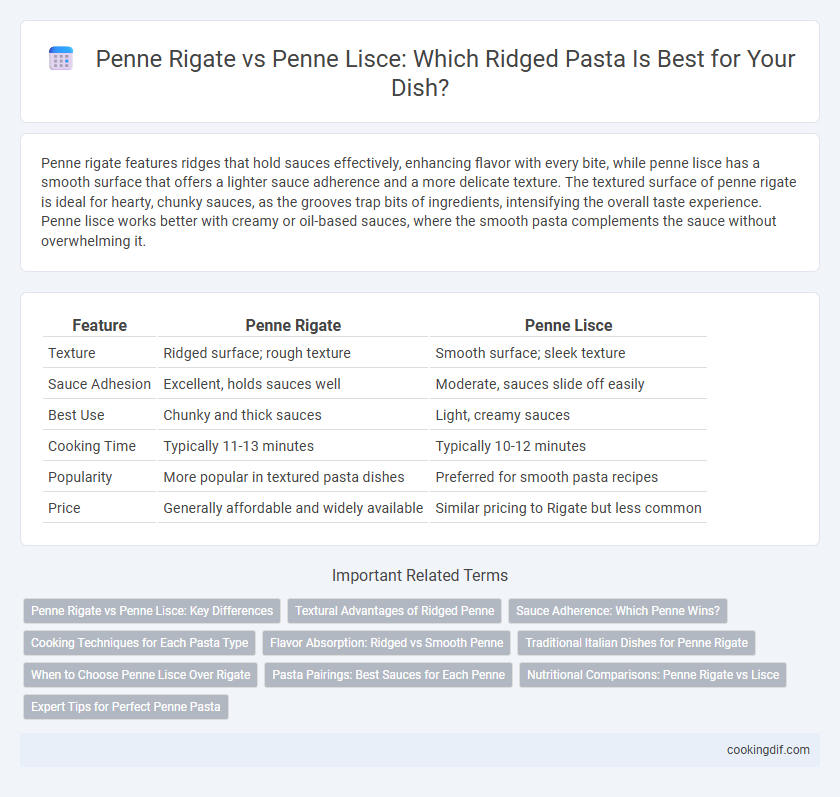Penne rigate features ridges that hold sauces effectively, enhancing flavor with every bite, while penne lisce has a smooth surface that offers a lighter sauce adherence and a more delicate texture. The textured surface of penne rigate is ideal for hearty, chunky sauces, as the grooves trap bits of ingredients, intensifying the overall taste experience. Penne lisce works better with creamy or oil-based sauces, where the smooth pasta complements the sauce without overwhelming it.
Table of Comparison
| Feature | Penne Rigate | Penne Lisce |
|---|---|---|
| Texture | Ridged surface; rough texture | Smooth surface; sleek texture |
| Sauce Adhesion | Excellent, holds sauces well | Moderate, sauces slide off easily |
| Best Use | Chunky and thick sauces | Light, creamy sauces |
| Cooking Time | Typically 11-13 minutes | Typically 10-12 minutes |
| Popularity | More popular in textured pasta dishes | Preferred for smooth pasta recipes |
| Price | Generally affordable and widely available | Similar pricing to Rigate but less common |
Penne Rigate vs Penne Lisce: Key Differences
Penne rigate features grooves along the surface, enhancing sauce adherence and delivering a more textured bite, while penne lisce has a smooth exterior that offers a silkier mouthfeel but less sauce retention. The ridges on penne rigate make it ideal for thicker, chunkier sauces as they trap ingredients more effectively, whereas penne lisce suits lighter, oil-based sauces due to its slick surface. Texture and sauce compatibility define the key differences between these two popular penne varieties.
Textural Advantages of Ridged Penne
Ridged penne, known as penne rigate, offers superior textural advantages over smooth penne lisce by capturing sauces more effectively within its grooves, enhancing each bite with richer flavor distribution. The ridges create increased surface area, allowing for better adherence of chunky, creamy, or oily sauces that cling to every ridge, preventing slipping and ensuring a well-coated pasta experience. This texture also provides a satisfying mouthfeel contrast, making penne rigate a preferred choice for robust, hearty pasta dishes where sauce retention is essential.
Sauce Adherence: Which Penne Wins?
Penne rigate outperforms penne lisce in sauce adherence due to its ridged surface, which effectively traps chunky and creamy sauces, enhancing flavor absorption with every bite. The grooves on penne rigate create increased texture, making it ideal for thick tomato sauces, pesto, and meat ragu compared to the smooth surface of penne lisce. This structural difference significantly impacts the overall sauce-to-pasta ratio, making penne rigate the preferred choice for dishes requiring optimal sauce clinging.
Cooking Techniques for Each Pasta Type
Penne rigate, with its ridged surface, holds onto sauces more effectively, making it ideal for thick, chunky sauces and baked dishes, as the grooves trap flavors and seasoning better during cooking. Penne lisce, being smooth, is best suited for lighter, cream-based sauces where a silky texture complements the pasta without the need for gripping sauce, requiring careful cooking time to avoid slipping from the pasta. Both types benefit from al dente cooking to maintain the perfect bite and texture, but Penne rigate's ridges enhance adhesion in dishes requiring robust sauce absorption.
Flavor Absorption: Ridged vs Smooth Penne
Penne rigate features ridges that enhance flavor absorption by trapping sauces more effectively than the smooth surface of penne lisce. These ridges create more texture, allowing thicker and chunkier sauces to cling better, intensifying the overall taste experience. Smooth penne, with its sleek surface, offers a milder flavor profile due to less sauce retention, making it ideal for lighter, cream-based sauces.
Traditional Italian Dishes for Penne Rigate
Penne rigate, characterized by its ridged surface, is preferred in traditional Italian dishes like penne all'arrabbiata and penne alla vodka because the grooves effectively trap sauces, enhancing flavor absorption and texture. Penne lisce, with its smooth surface, is less common in classic recipes as it does not hold thick sauces as well, leading to a less intense taste experience. The texture difference makes penne rigate the ideal choice for robust, hearty sauces central to authentic Italian cuisine.
When to Choose Penne Lisce Over Rigate
Penne lisce offers a smooth texture that works best for lighter sauces like olive oil or simple tomato, allowing the flavor to shine without collecting excess sauce. This type of pasta is ideal in baked dishes where its sleek surface prevents clumping and ensures even baking. Choosing penne lisce over rigate enhances dishes requiring a delicate balance of sauce and pasta texture.
Pasta Pairings: Best Sauces for Each Penne
Penne rigate, with its ridged surface, effectively holds chunky sauces like marinara, Bolognese, or pesto, enhancing each bite with robust texture and flavor. Penne lisce, being smooth, pairs best with lighter, cream-based or olive oil sauces that cling gently without overwhelming the pasta's delicate form. Choosing between rigate and lisce impacts sauce adherence and overall mouthfeel, making pasta and sauce compatibility essential for an optimal dining experience.
Nutritional Comparisons: Penne Rigate vs Lisce
Penne rigate and penne lisce have similar macronutrient profiles, including calories, carbohydrates, and protein levels, as they are both made from durum wheat semolina. The ridges on penne rigate enhance sauce adherence, potentially increasing the nutritional intake of added ingredients like healthy fats or vitamins from vegetables. Textural differences do not significantly alter the intrinsic nutrient content, but penne rigate's surface allows for a more nutrient-dense meal by capturing more sauce and seasoning compared to the smooth penne lisce.
Expert Tips for Perfect Penne Pasta
Penne rigate features ridges that hold onto sauces better, enhancing flavor absorption and providing a more textured bite compared to penne lisce, which has a smooth surface ideal for lighter sauces. Experts recommend using penne rigate for thick, chunky sauces like bolognese or arrabbiata to maximize sauce adherence and mouthfeel. For dishes with delicate or creamy sauces, penne lisce offers a sleek texture that complements subtle flavors without overwhelming the palate.
Penne rigate vs penne lisce for ridged pasta Infographic

 cookingdif.com
cookingdif.com